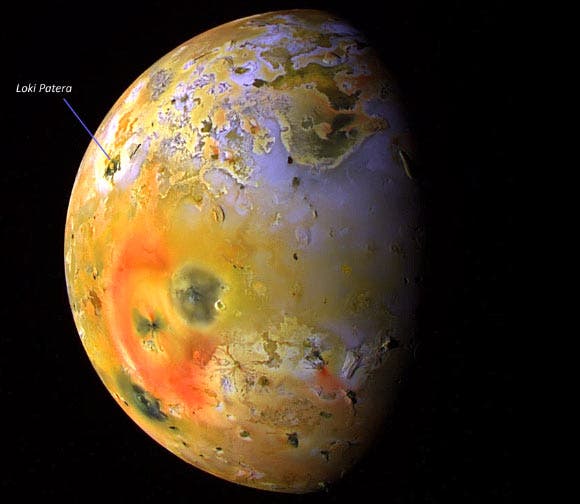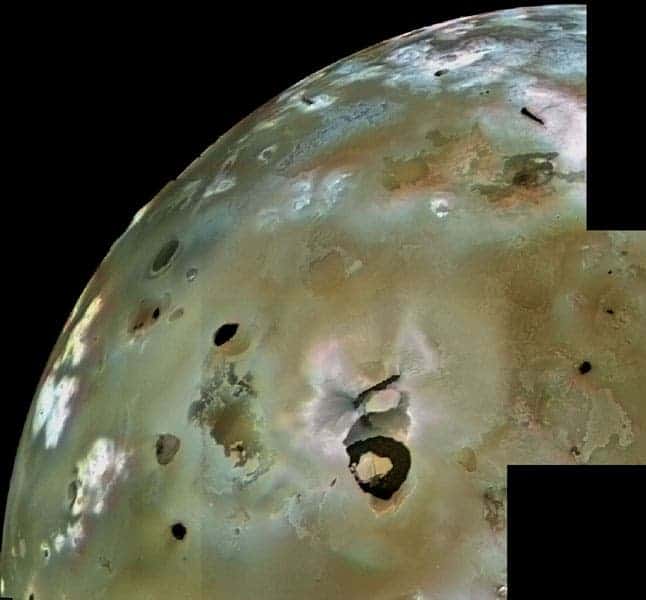Scientists analyzing data from the Large Binocular Telescope Observatory in Arizona spotted a huge lava lake on Io, one of Jupiter’s largest moons.

This global view of Io was obtained by NASA’s Galileo spacecraft on 19 September 1997 at a range of more than 500,000 km (310,000 miles). In this image, deposits of sulfur dioxide frost appear in white and grey hues while yellowish and brownish hues are probably due to other sulfurous materials. Bright red materials and ‘black’ spots with low brightness mark areas of recent volcanic activity and are usually associated with high temperatures and surface changes. Image credit: NASA / JPL / University of Arizona.
We’ve known for a while that Io is quite an amazing (and hellish) place; it’s the most geologically active place in the solar system, with extreme geologic activity occurring as a result of tidal friction. As both Jupiter and the other Galilean satellites – Europa, Ganymede and Callisto – tug and pull, Io’s interior generates huge amount of friction, which in turn generate very high levels of volcanism. Several volcanoes produce plumes of sulfur and sulfur dioxide that go as high as 500 km (300 mi) above Io’s surface. The satellite is dotted with over 100 high mountains created as a result of this extreme geology, with some of the mountains taller than Mount Everest – something remarkable for a satellite 4 times smaller than Earth.
The largest of these volcanic features is called Loki, after the Norse god of fire and chaos – and a fitting name it is. The Loki Patera depression is 202 kilometres (126 mi) in diameter, which is huge for a volcanic feature, but when you consider the distance from Earth to Io, it’s almost insignificant. In fact, until recently, it couldn’t be seen from Earth. But now, thanks to the Large Binocular Telescope Interferometer (LBTI), a group of astronomers was able to see it from Earth for the first time.
“We have seen bright emissions – always one unresolved spot – ‘pop-up’ at different locations in Loki Patera over the years. New images from the LBTI show for the first time that these emissions arise simultaneously from different sites in Loki Patera,” said Prof Imke de Pater of the University of California, Berkeley.

A huge area of Io’s volcanic plains is shown in this Voyager 1 image mosaic. Numerous volcanic calderas and lava flows are visible here. Loki Patera, an active lava lake, is the large shield-shaped black feature. Image via NASA/ JPL.
Their research confirms previous theories – that there’s a massive lava lake at the Loki Patera.
“This strongly suggests that the horseshoe-shaped feature is most likely an active overturning lava lake, as hypothesized in the past.”
Team member Dr Chick Woodward from the University of Minnesota added: “studying the very dynamic volcanic activity on Io, which is constantly reshaping the moon’s surface, provides clues to the interior structure and plumbing of this moon.”
But aside from finding a massive lava lake on what should be a frozen moon, this study could have massive implications for extraterrestrial life. Io itself is not habitable, but it’s the best place in our solar system to study tidal heating and tidal volcanism – which is crucial for potential extraterrestrial life on places like Europa, Saturn’s moon. It also helps with some of NASA’s (and other space agencies) future missions.
“It helps to pave the way for future NASA missions such as the Io Observer. Io’s highly elliptical orbit close to Jupiter is constantly tidally stressing the moon, like the squeezing of a ripe orange, where the juice can escape through cracks in the peel.”









